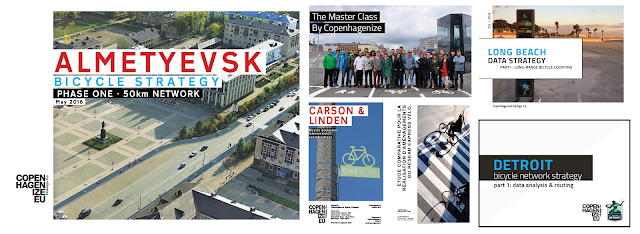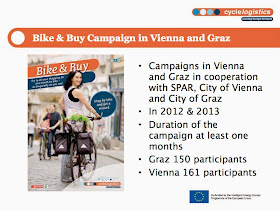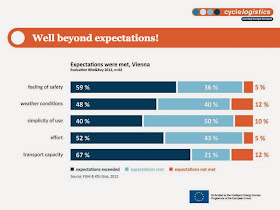Copenhagenize.com - Bicycle Culture by Design: 2016 in Review
Read More

I love the title of this photo by Cheekipoo on Flickr.It sums up the Copenhagen way of life as concisely as possible.The trumpet repair shop had plenty of bike parking.How many people in this city of 1.9 million could possibly require the assistance of a trumpet repair shop? Not many. Nevertheless, the trumpet repair shop provides extensive bike parking possibilities for its customers.
Brilliant.
 As the graphic above indicates, the potential for switching to bicycles and cargo bikes in European cities is impressive, according to a Cyclelogistics.eu baseline study. 51% of all motorised trips related to goods transport could realistically be done on bikes and cargo bikes. This is a good thing.
As the graphic above indicates, the potential for switching to bicycles and cargo bikes in European cities is impressive, according to a Cyclelogistics.eu baseline study. 51% of all motorised trips related to goods transport could realistically be done on bikes and cargo bikes. This is a good thing. 
Copenhagenize Design Company have been involved with the brilliant Cyclelogistics.eu project for two and a half years now. The project is aimed at promoting the use of cargo bikes in European cities.
We've recently posted about our Shop by Bike campaign here in Copenhagen and for the past two and half years there have been great initiatives in all of our partner cities.
Our partner in Graz, Austria - FGM Amor - have spearheaded a Cyclelogistics baseline study about how much of the the goods transport in a city could realistically be switched to cargo bikes and bicycles.
In the above graphic you can see what the transport equation looks like in European cities. The composition of trips in European cities looks like this, above.
The composition of trips in European cities looks like this, above.  Here we outline the shift potential.
Here we outline the shift potential. All logistics have the potential to shift to bikes, but shopping has the greatest potential for reducing car use.
All logistics have the potential to shift to bikes, but shopping has the greatest potential for reducing car use. In addition, Cyclelogistics did a campaign in Graz and Vienna, in collaboration with the SPAR supermarket chain.
In addition, Cyclelogistics did a campaign in Graz and Vienna, in collaboration with the SPAR supermarket chain. The campaign revealed why the particpants didn't shop by bike.
The campaign revealed why the particpants didn't shop by bike. After participating in the campaign, there were pleasant results. The expectations of the participants were exceeded in every category. A whole lot of mythbusting busted a whole lot of myths. All by getting people out of their perception bubble and onto the bicycle infrastructure to try it for themselves.
After participating in the campaign, there were pleasant results. The expectations of the participants were exceeded in every category. A whole lot of mythbusting busted a whole lot of myths. All by getting people out of their perception bubble and onto the bicycle infrastructure to try it for themselves. There were, of course, areas that the participants thought needed improvement. Not suprisingly, safe infrastructure for cycling was the main one. Parking and incentives were close behind.
There were, of course, areas that the participants thought needed improvement. Not suprisingly, safe infrastructure for cycling was the main one. Parking and incentives were close behind. Participants were asked what they thought about potential services that could be provided for them.
Participants were asked what they thought about potential services that could be provided for them. The results were positive. Beyond our own expectations.
The results were positive. Beyond our own expectations.


There was recently a consumer test of bicycle helmets in Denmark, performed by The Danish Consumer Council in their magazine Tænk (Think). The test involved 15 different skater-style helmets. Two of the helmets failed in the test. One was Etto’s “Psycho Street” and the other was Nutcase Helmet’s “Street” model. The one with the very appropriate DANGER text on it. (The perfect text, by the way, to describe the helmet industry’s eagerness to portray cycling as more dangerous as it is in the interest of profit.) Of the two helmets that flopped, Etto immediately called back the helmets in question and offer refunds to consumers. Nutcase Helmets, on the other hand, refused to react to the results of the test. They replied that their helmets met the demands in “their own tests”.
Another example, while we're on the topic, of helmet manufacturers who happily ignore safety warnings in the name of cash is the Danish Yakkay helmet brand. We've covered that previously.
Okay, with all this said, let's add some grains of salt. The Danish Consumer Council have little knowledge of helmets and their limitations. They merely look at the European Union standard, EN1078, and test the helmets to see if they meet the requirements. They don't even have a test facility themselves, instead outsourcing to a German facility. They do not question the fact that the EU standard is one of the weakest in the world or that the phelmet industry is involved in deciding the standards. Which is kind of like the tobacco industry sitting at the table when health warnings and smoking laws are decided upon.They don't question the fact that helmets are only tested for impact on the top of the helmet and not on the sides or front or back and that they don't protect against dangerous rotational injuries. All of this is perhaps more of an issue for The Danish Council of Ethics and similar councils abroad.
The article itself is from a freebie newspaper and the journalist clearly just copy/pasted it together inbetween sipping coffee and checking his emails. He quotes the usual suspects from the Danish Road Safety Council - again, a council that doesn't have any scientific experience - or respect for science - and runs campaigns based on projecting their own perception on fear onto the population at large rather than using facts or worrying about the negative effects of helmet promotion. For example, as the European Council of Ministers of Transport have said in their report "National Policies to Promote Cycling":
Then there is this article "How helmet promotion and laws affect cycle use" and our previous article by sociologist Dave Horton about Fear of Cycling and Helmet Promotion. In addition there is The Culture Fear relating to bicycle helmets.
There are an awful lot of people in this fear game who don't have much knowledge about helmets. Most are foolish, lazy people who are not aware of the consequences of promoting sub-standard safety equipment that is only designed to protect a head from non-life threatening impacts, on the crown of the head, in solo accidents under 20 km/h and instead giving people (read: consumers with cash to spend) the impression that helmets will save their lives. Then there are those who profit from selling helmets. At least their relutance to address the facts is clear cut. It will affect profit. Doesn't make it right, but at least their intentions are clear. All of this is rather nonsensical when you consider that most helmets on the market don't do much more than line the pockets of companies.Ever Lazer helmets call rotational injury The Absolute Enemy.
So. Will Nutcase: A. Withdraw their faulty products from the market?B. Start producing and promoting motorist helmets instead? At least THAT will have a positive effect on promoting cycling and speed the journey to fewer car trips by scaring people out of cars, instead.
Here's the gist of the article translated into English:Two of the most sold bicycle helmets are not safe enough, a new test from the The Danish Consumer Council's magazine Tænk (Think) shows. The helmets from Etto and Nutcase are not good enough at absorbing shock and that increases the risk of serious injury. Etto is recalling the helmets in question but Nutcase refuses to respond. The helmet producer said to Tænk that the helmets pass their own tests. ”Nutcase is putting cyclists' safety at risk by keeping the helmets on the market. It could cost lives at the end of the day”, says Niels Ebbe Jacobsen, head of testing at Tænk. The helmets from Etto and Nutcase are popular skater-type helmets. In Tænk's test, skater-type helmets received lower marks compared to other styles because of reduced ventilation.
Although many skater helmets like Mango X-ride did just as well as traditional bicycle helmets in tests.
